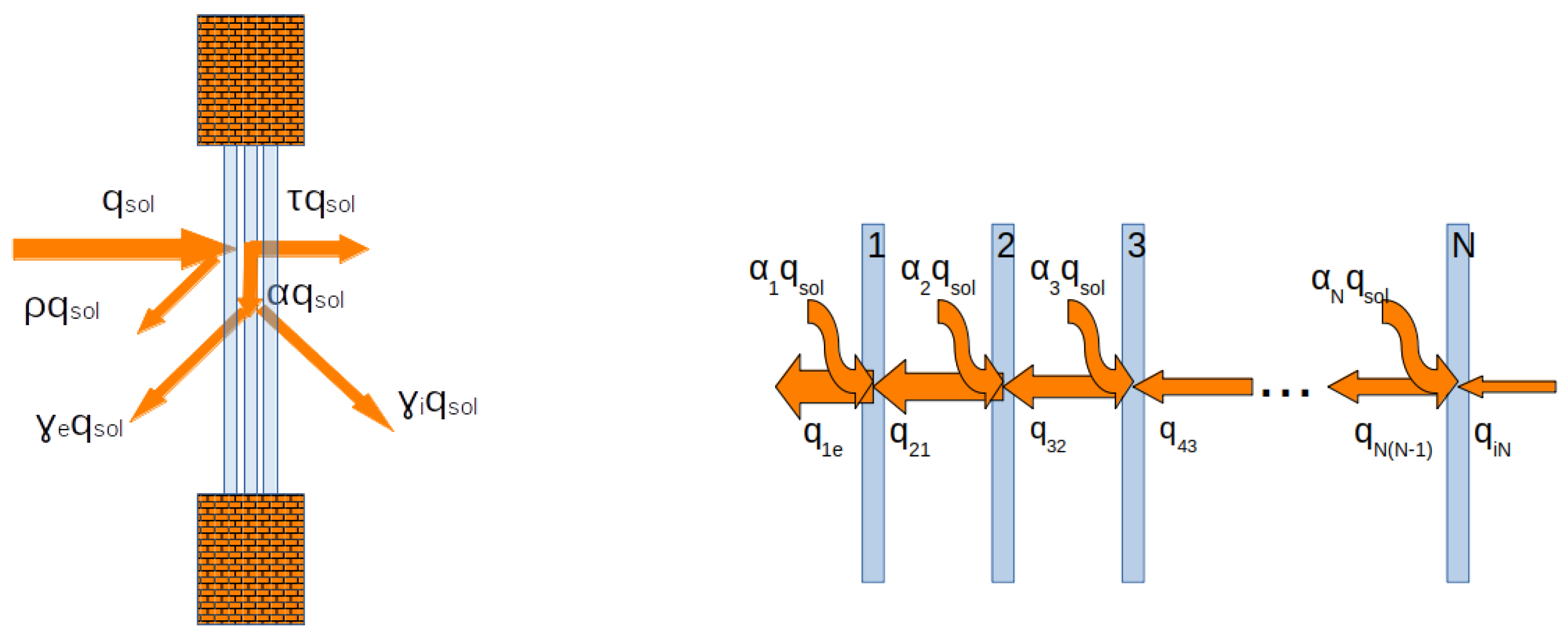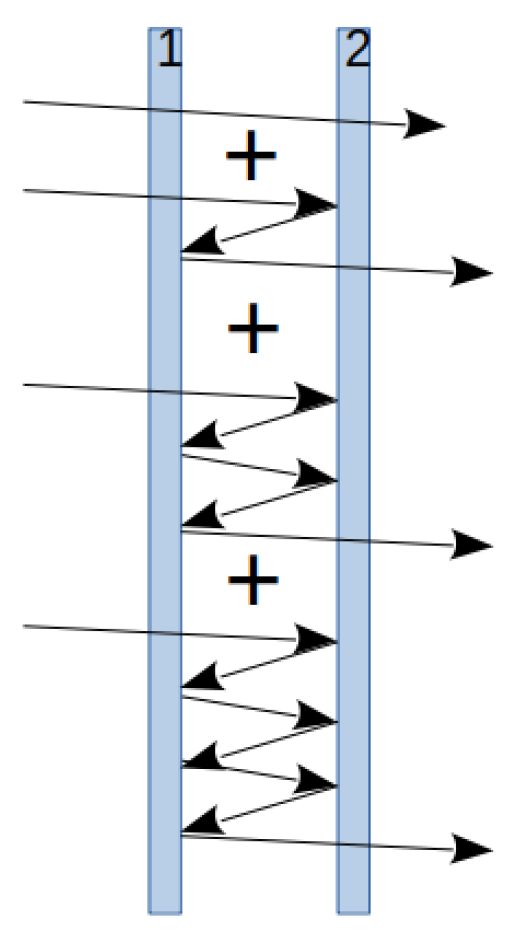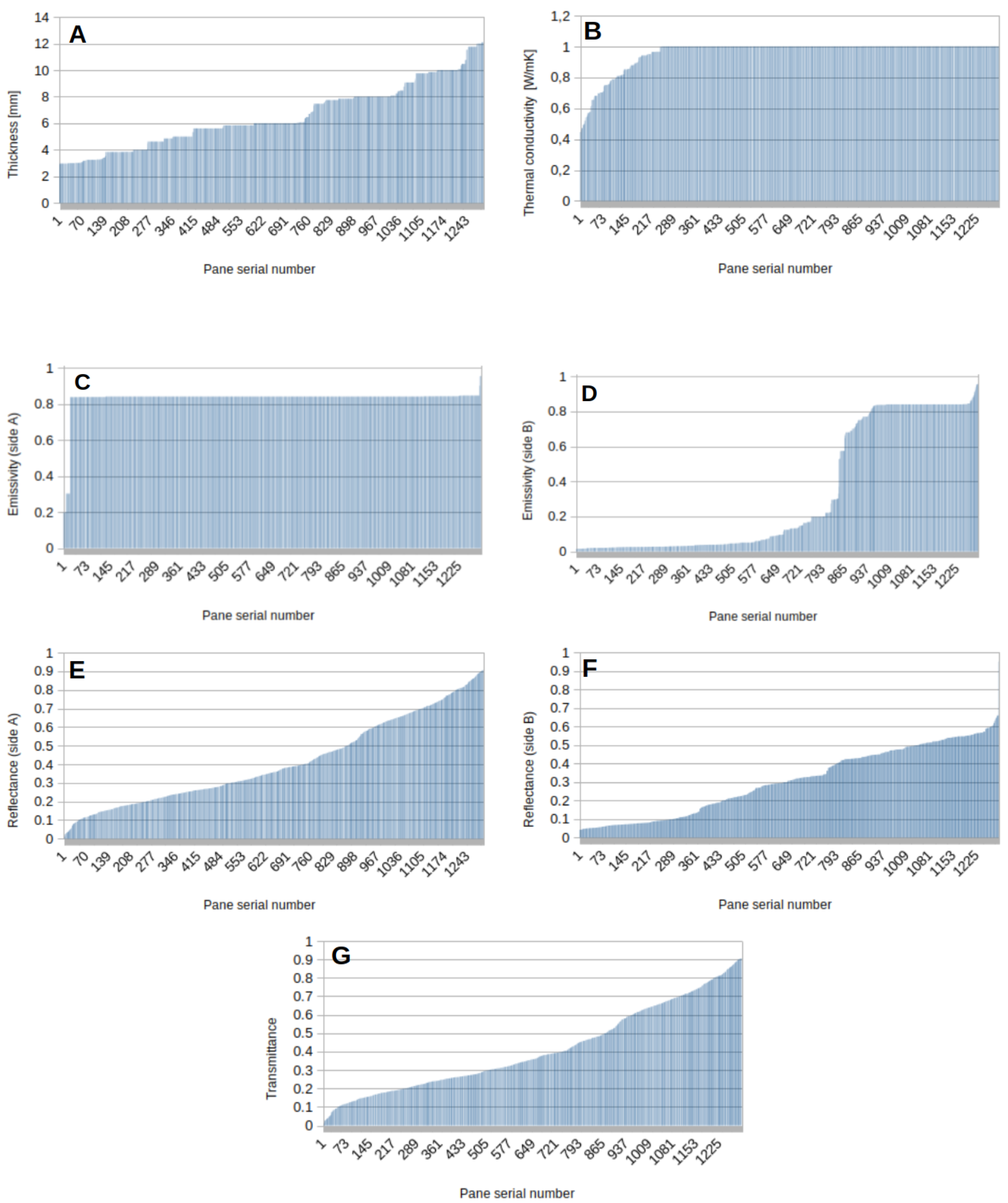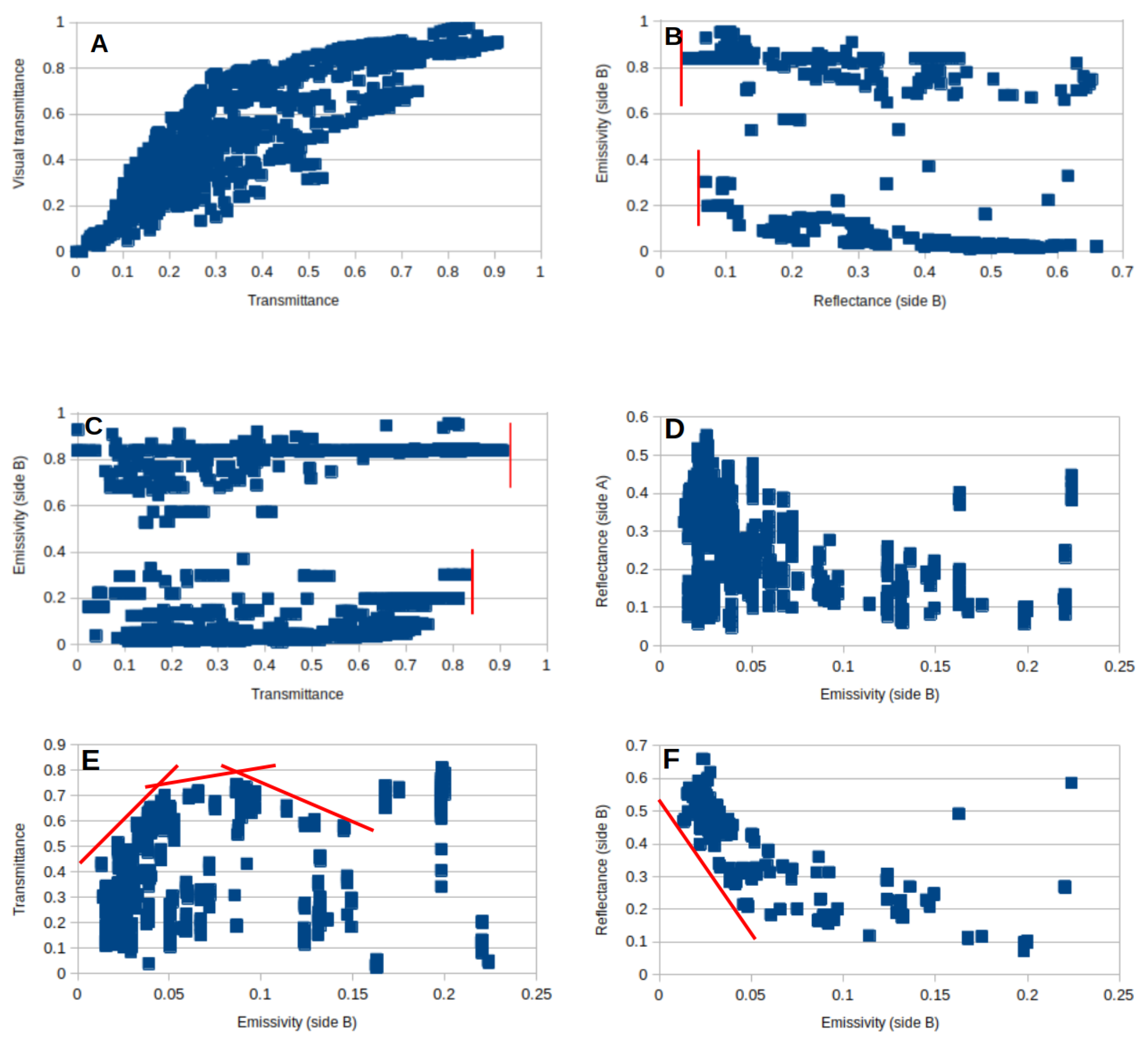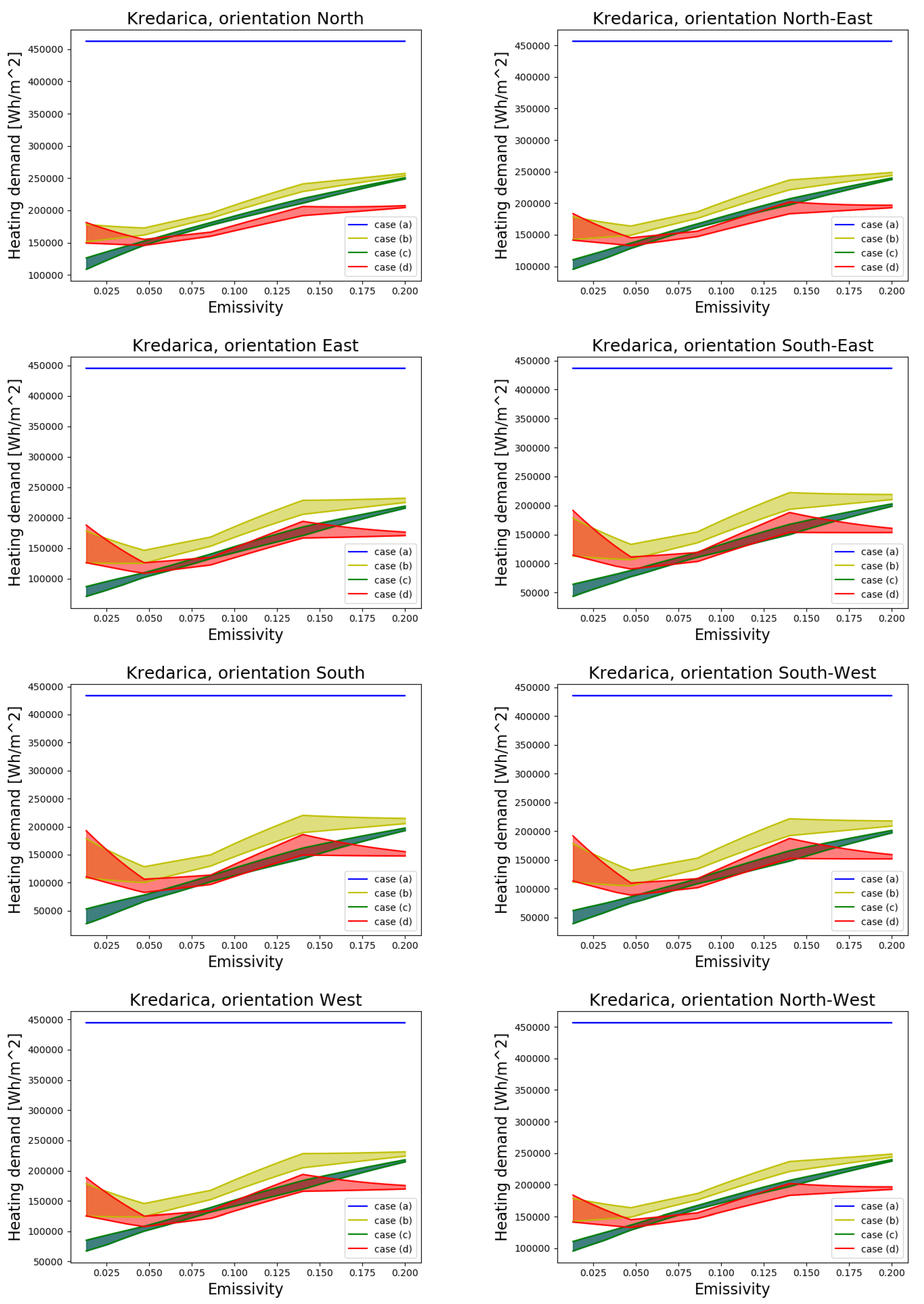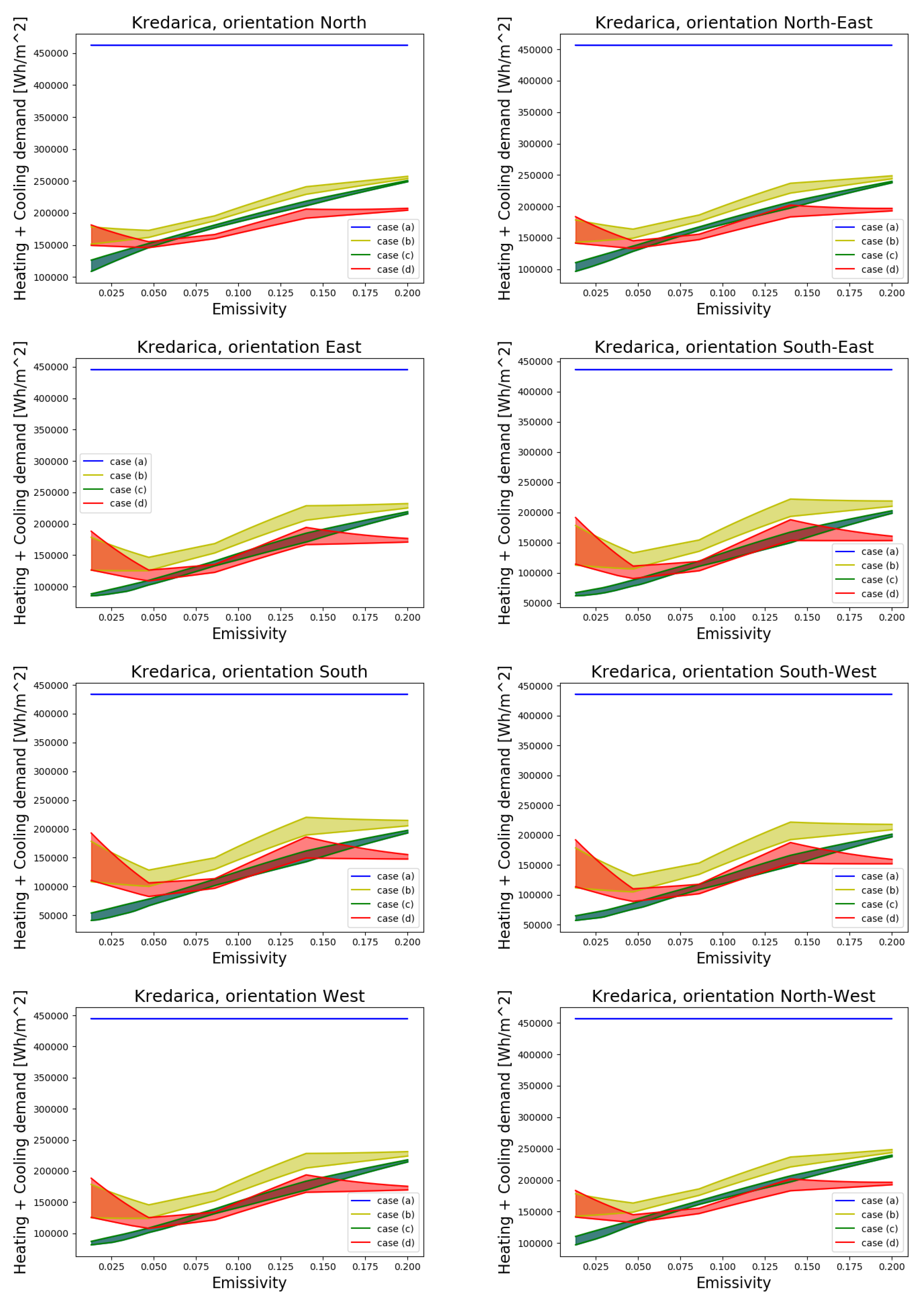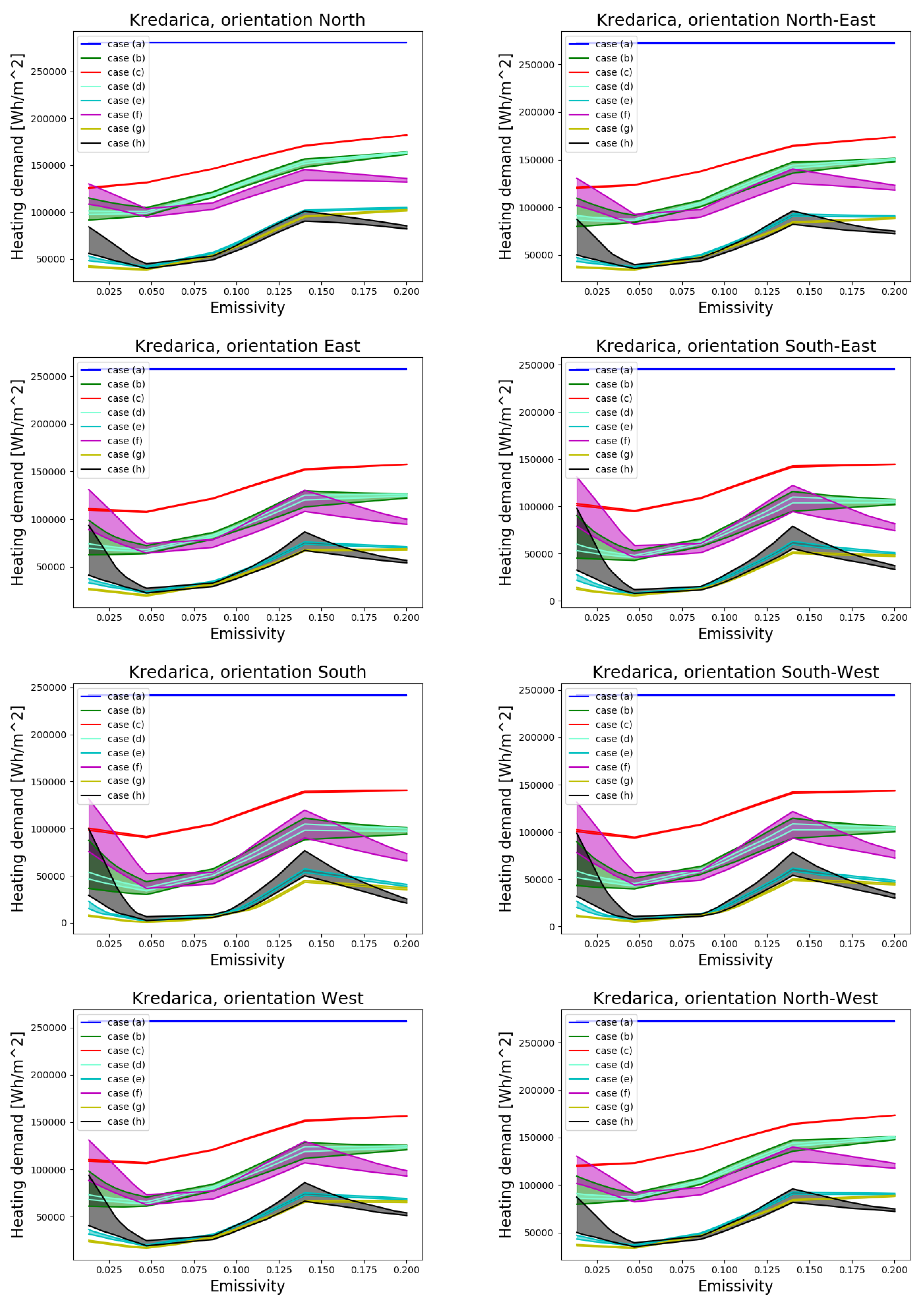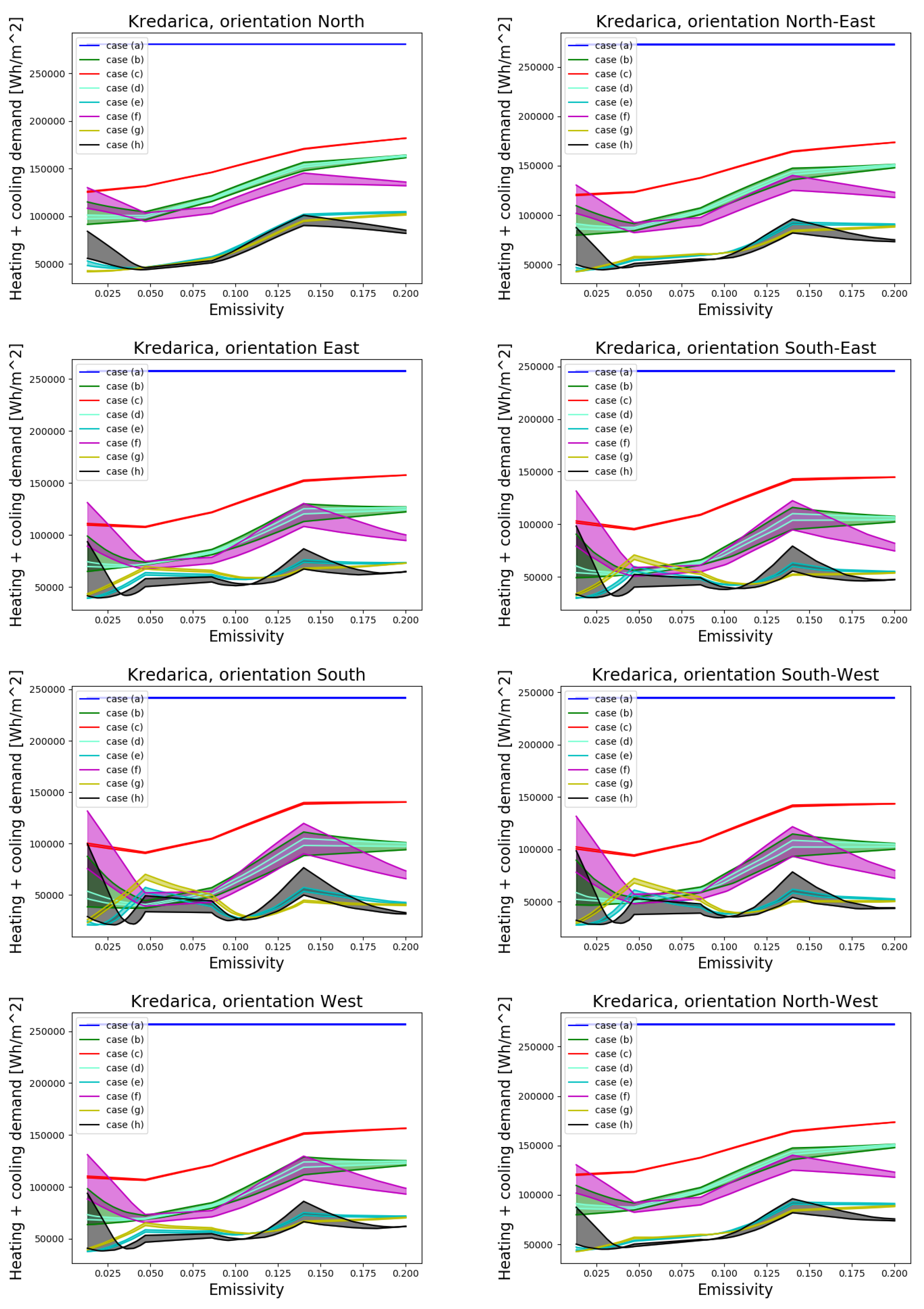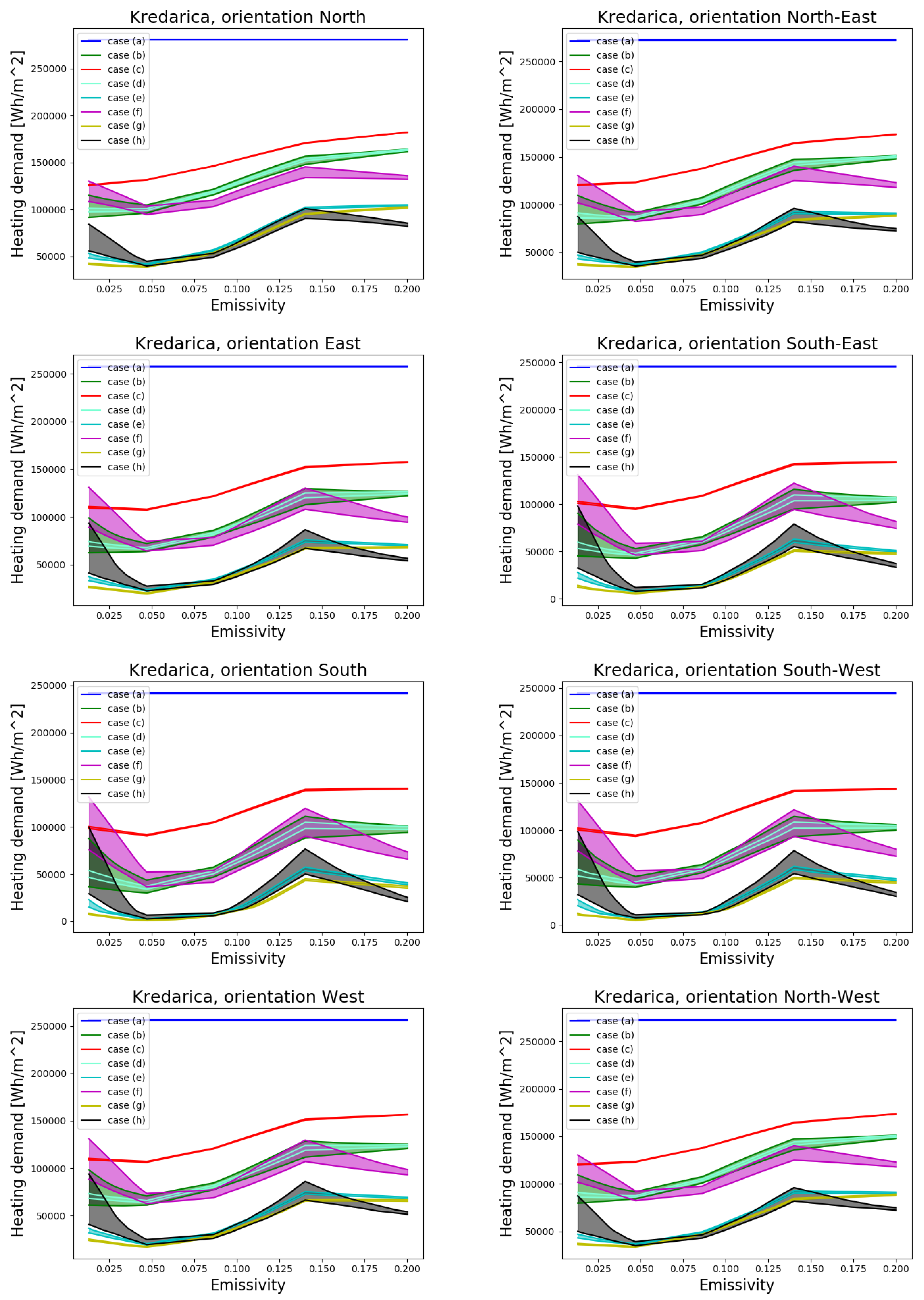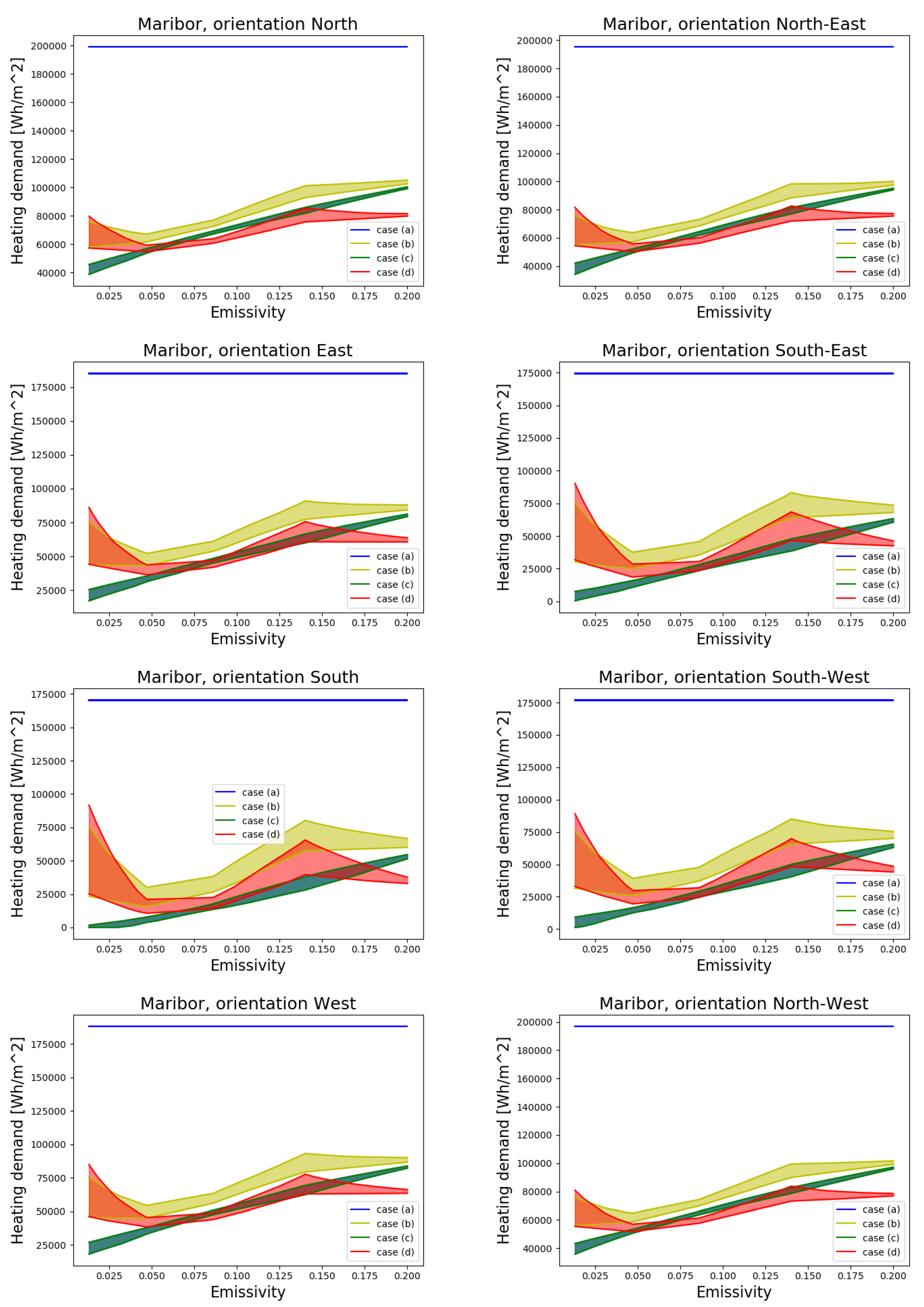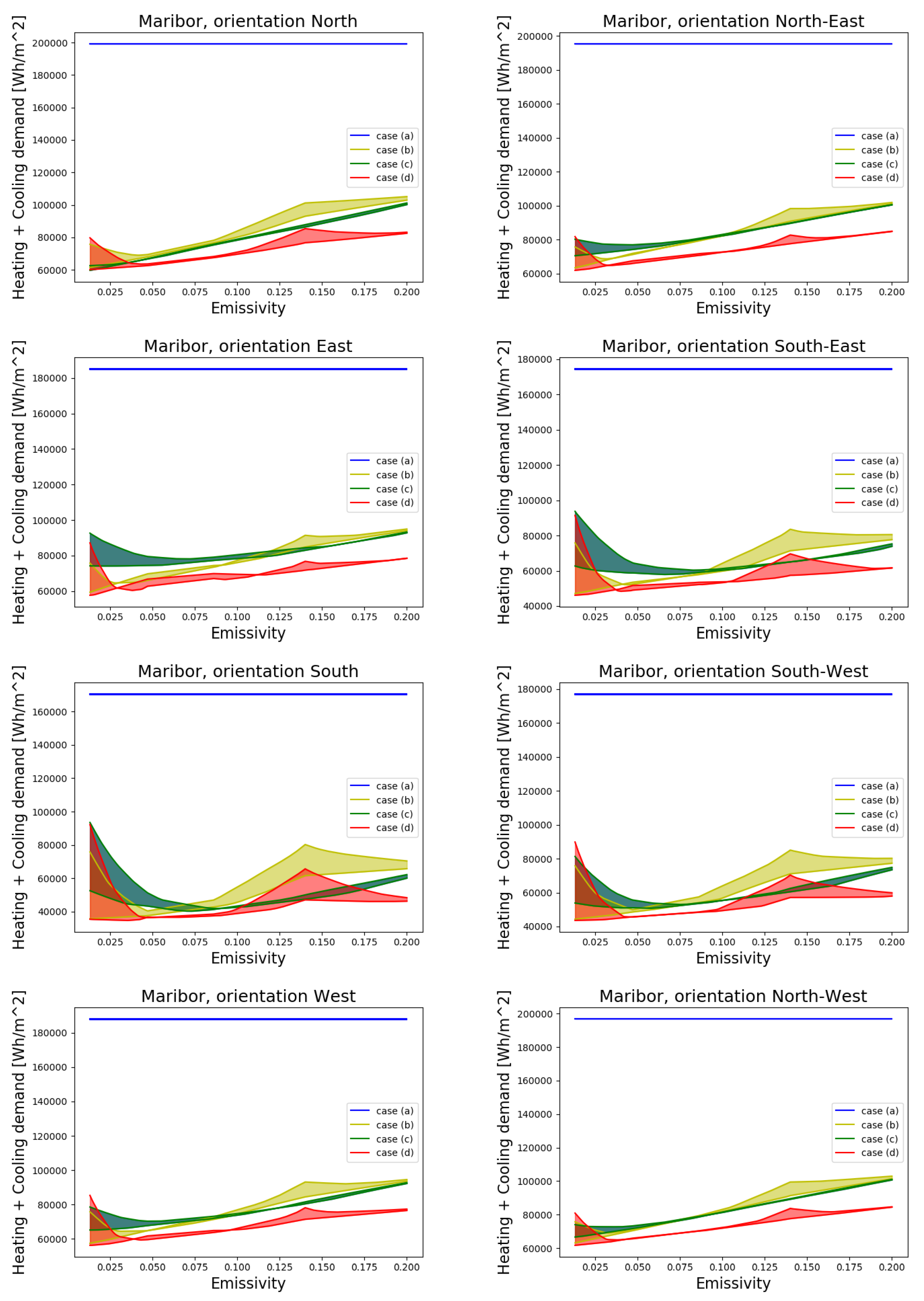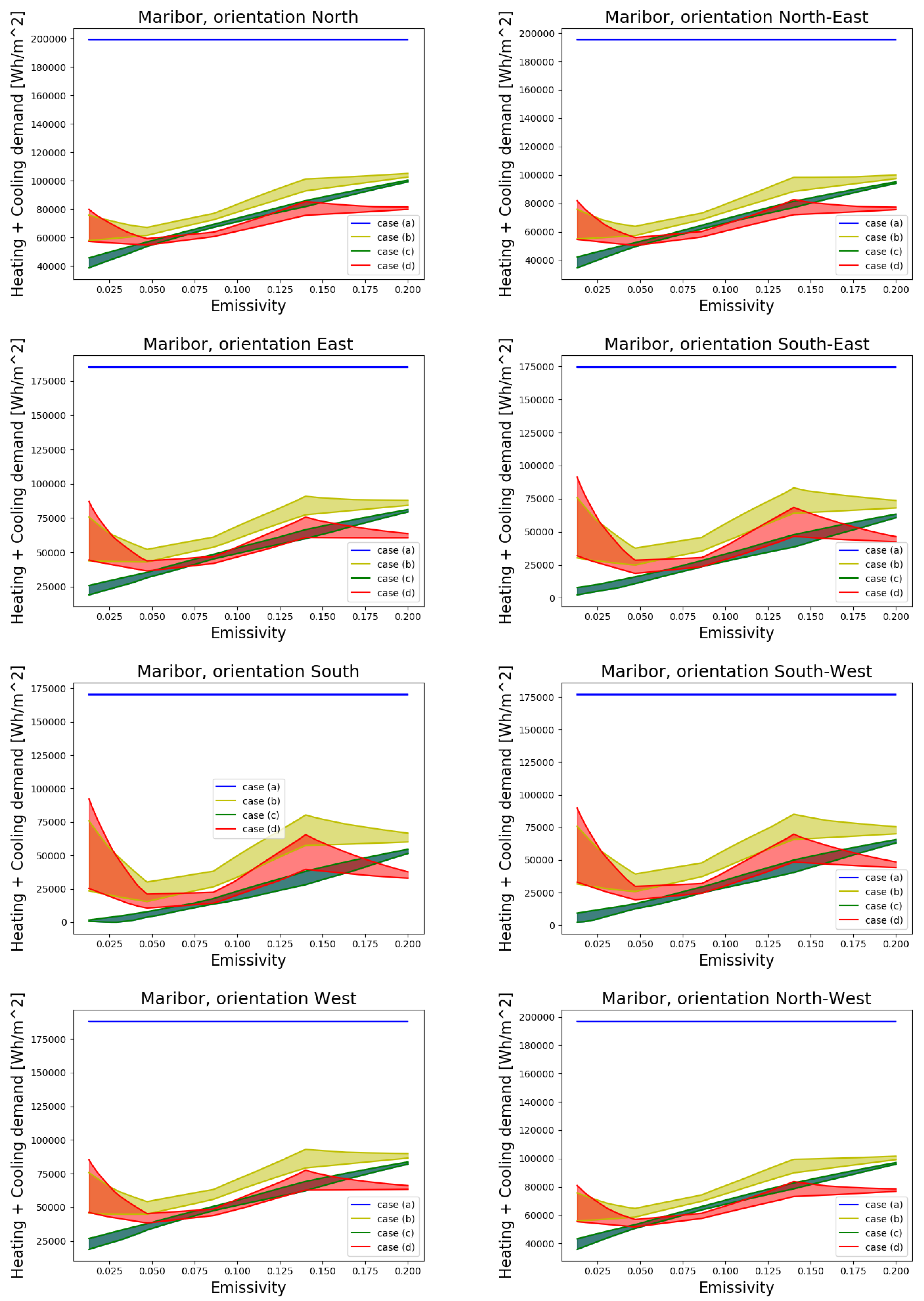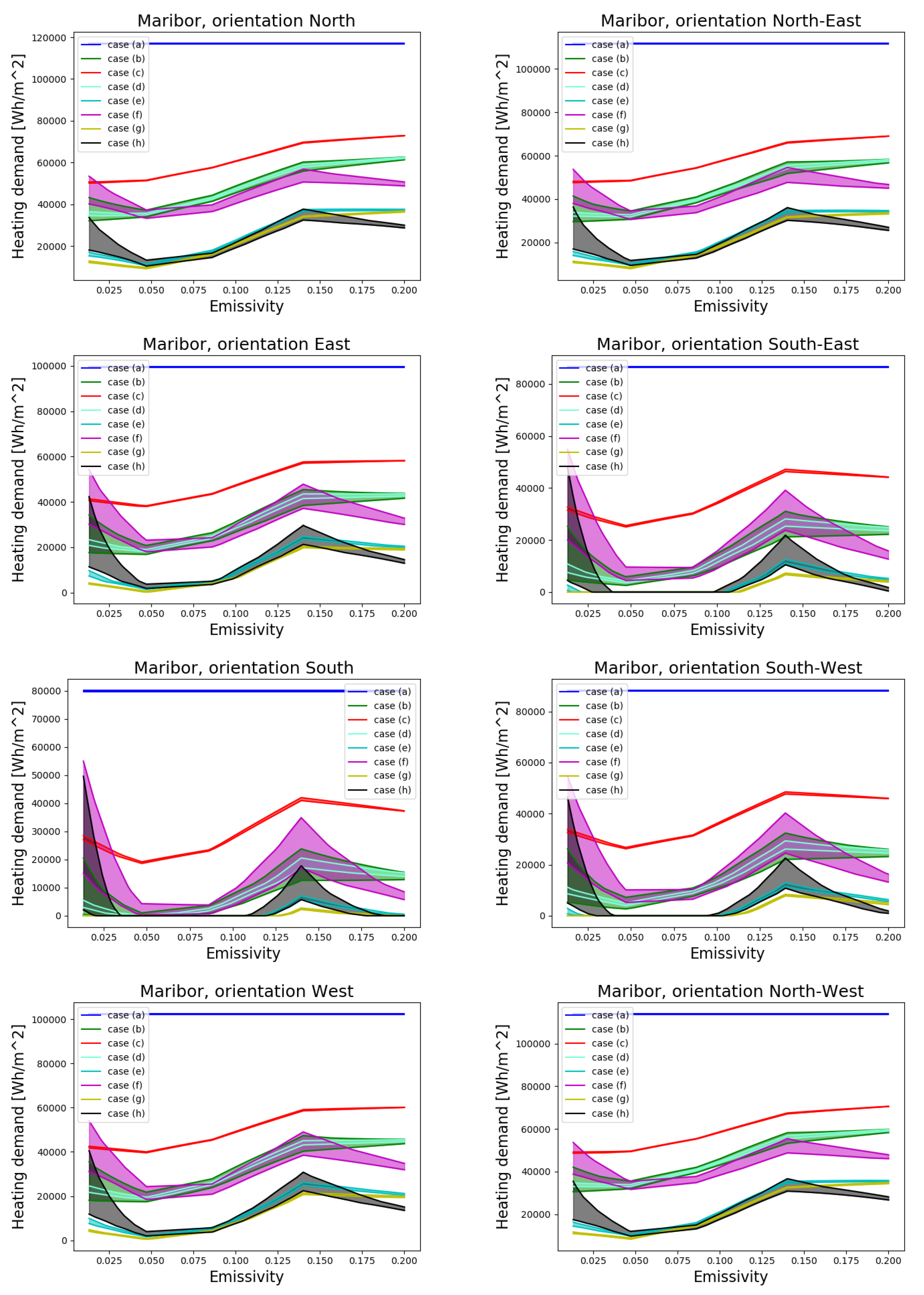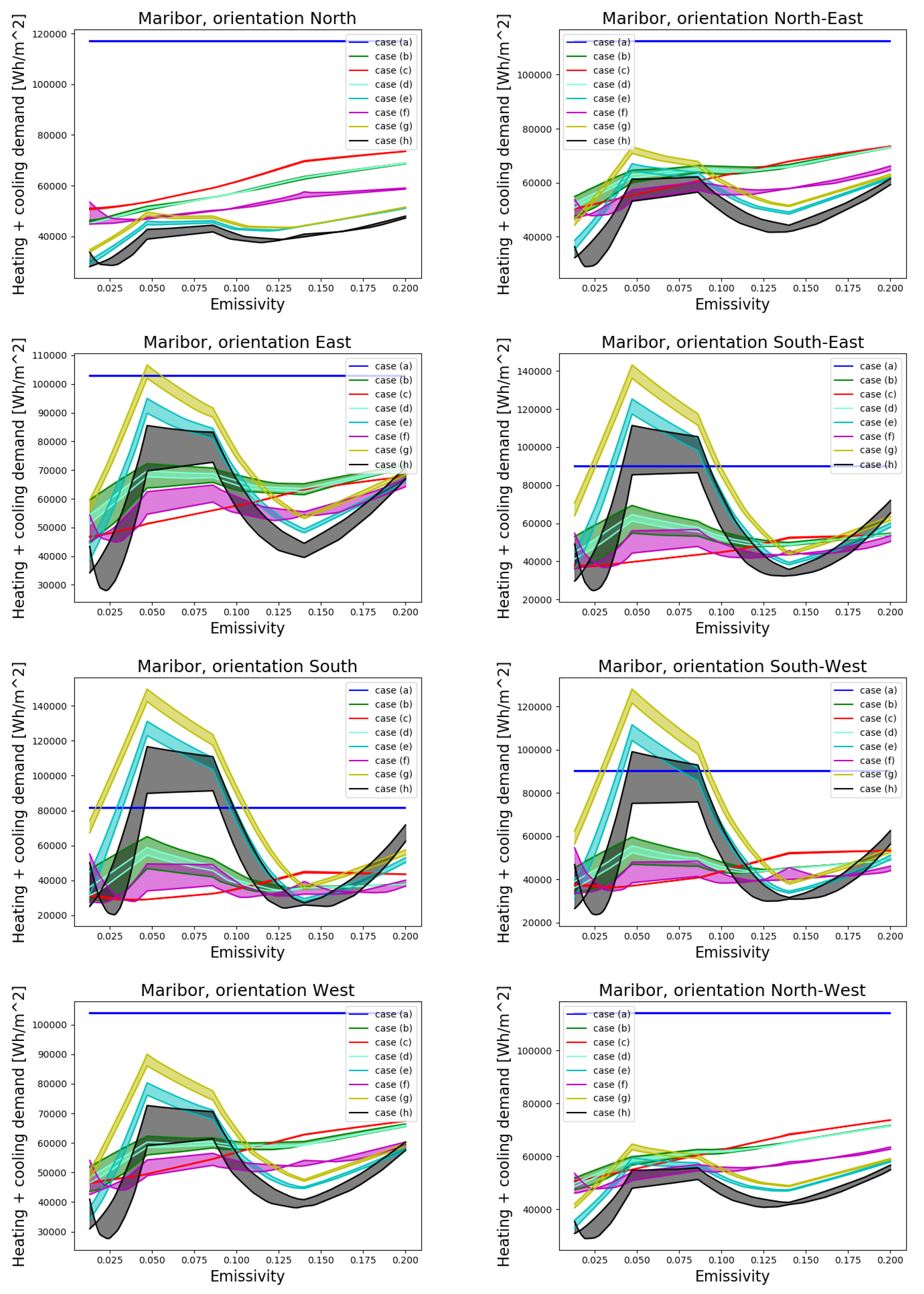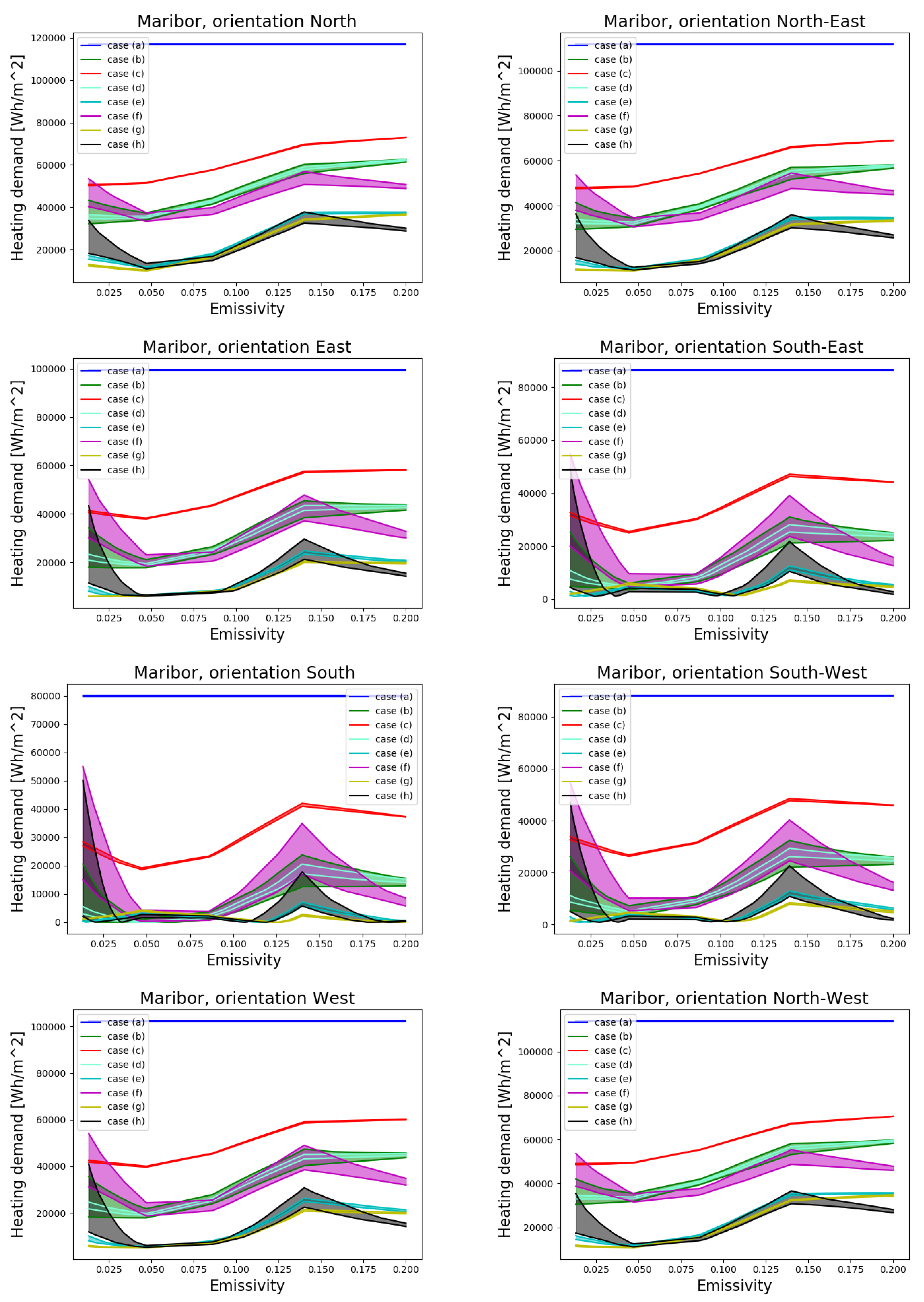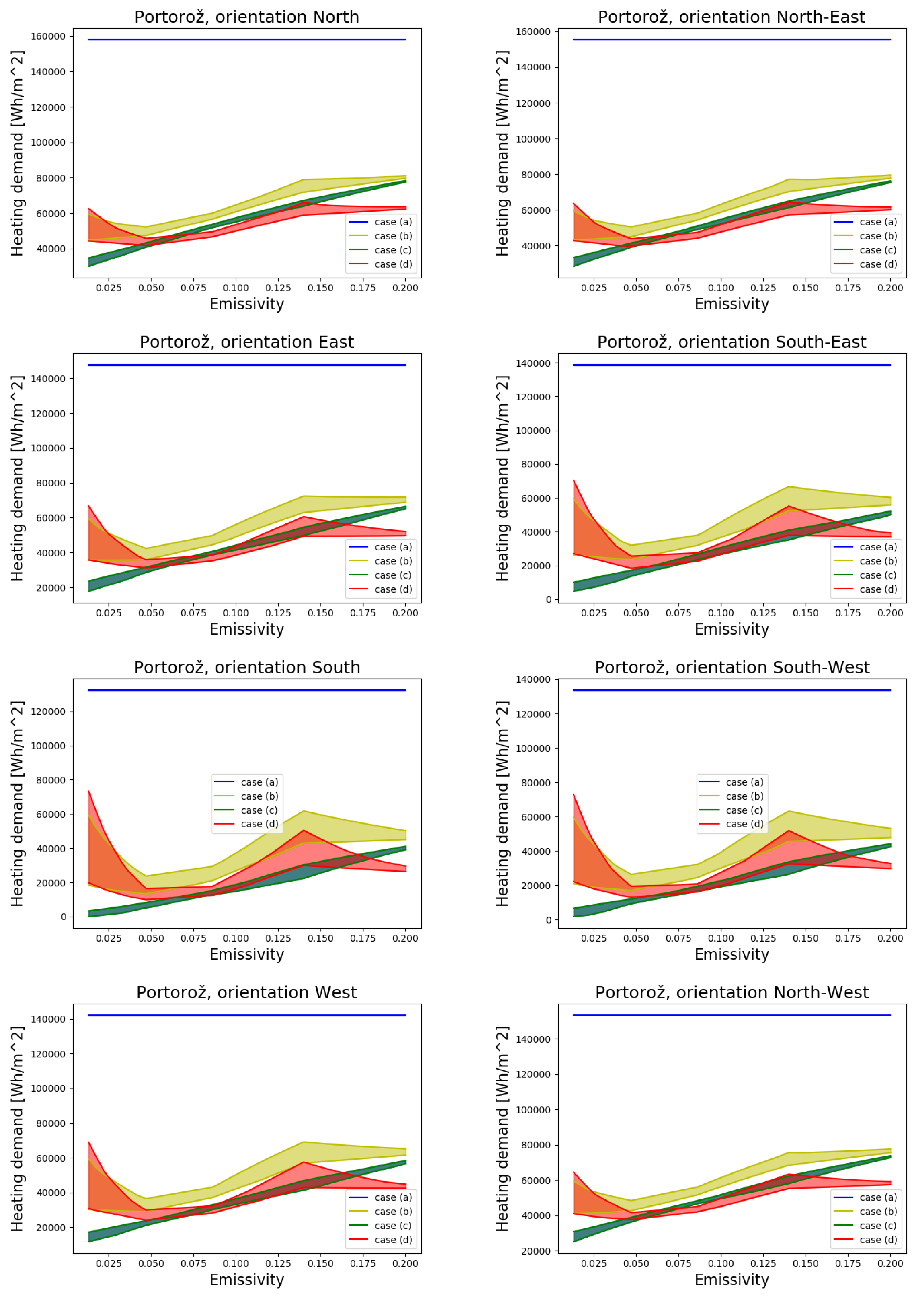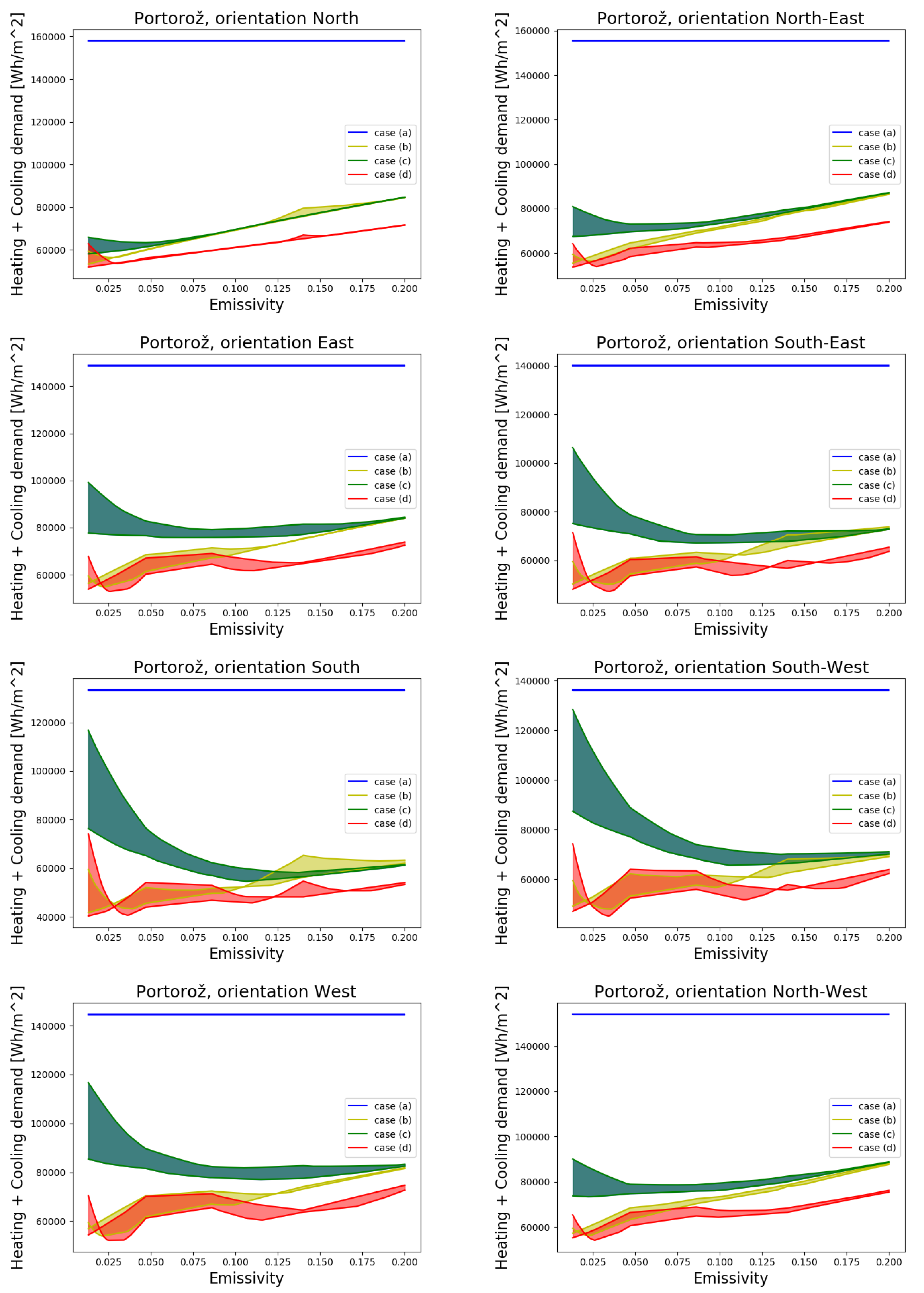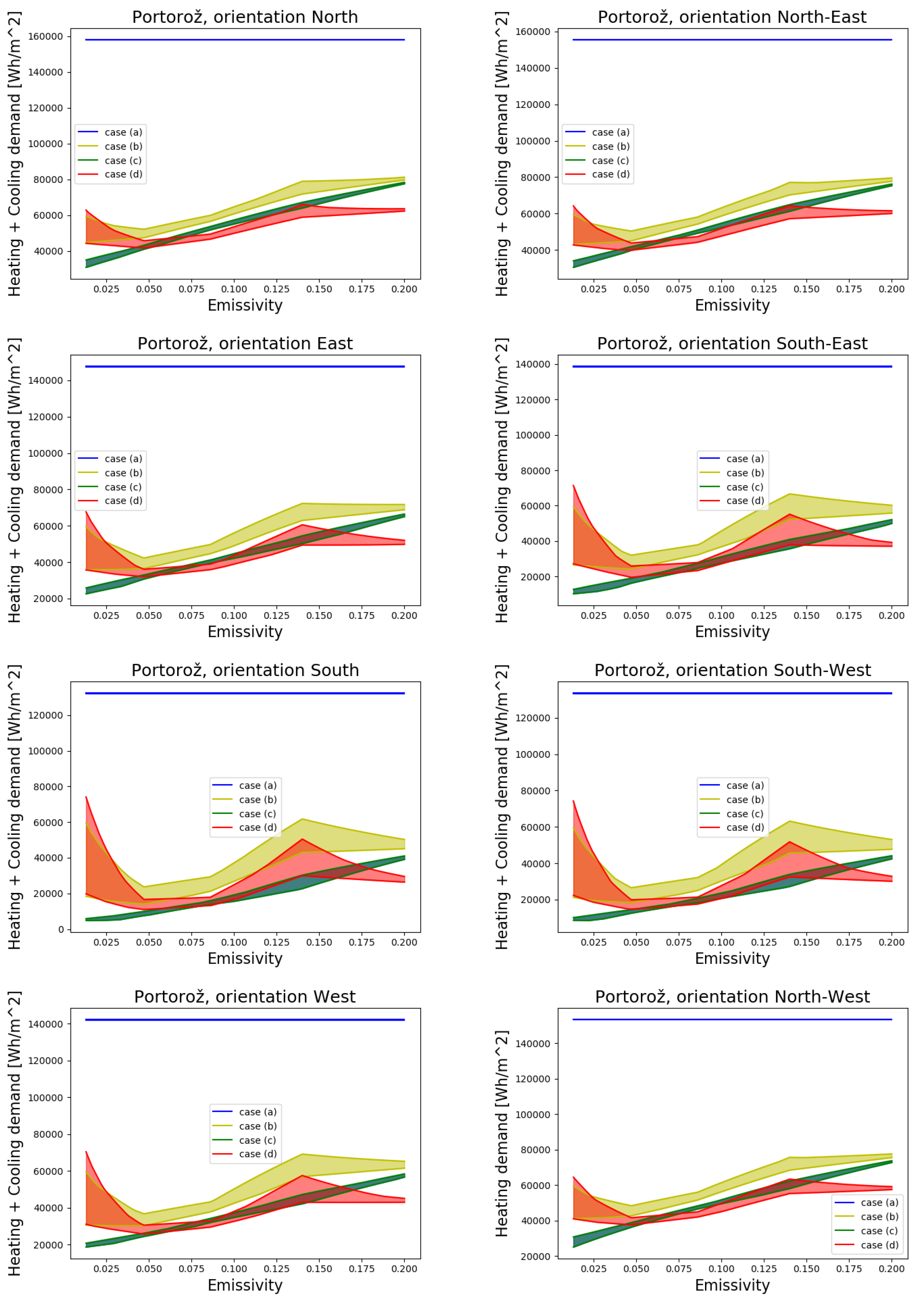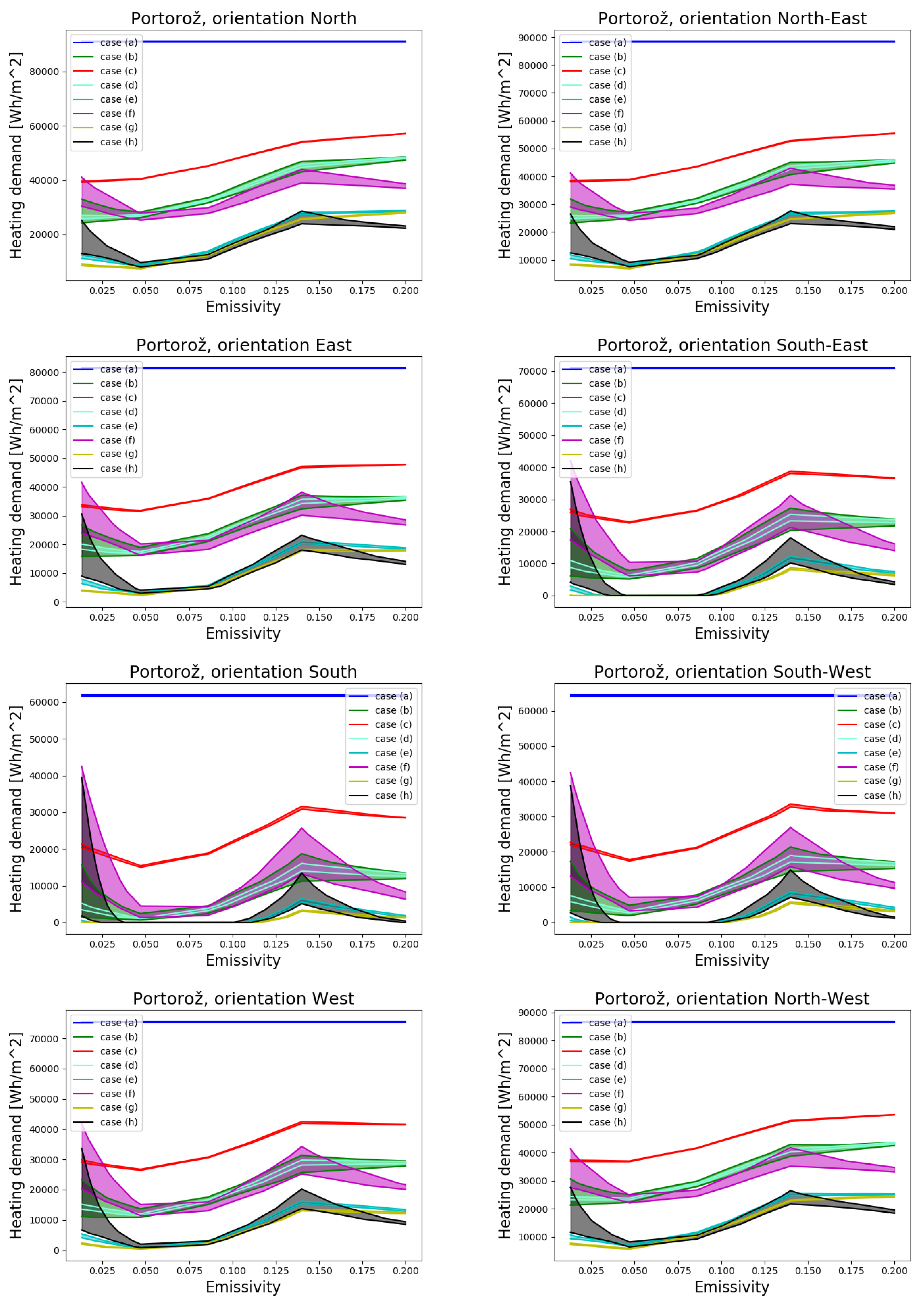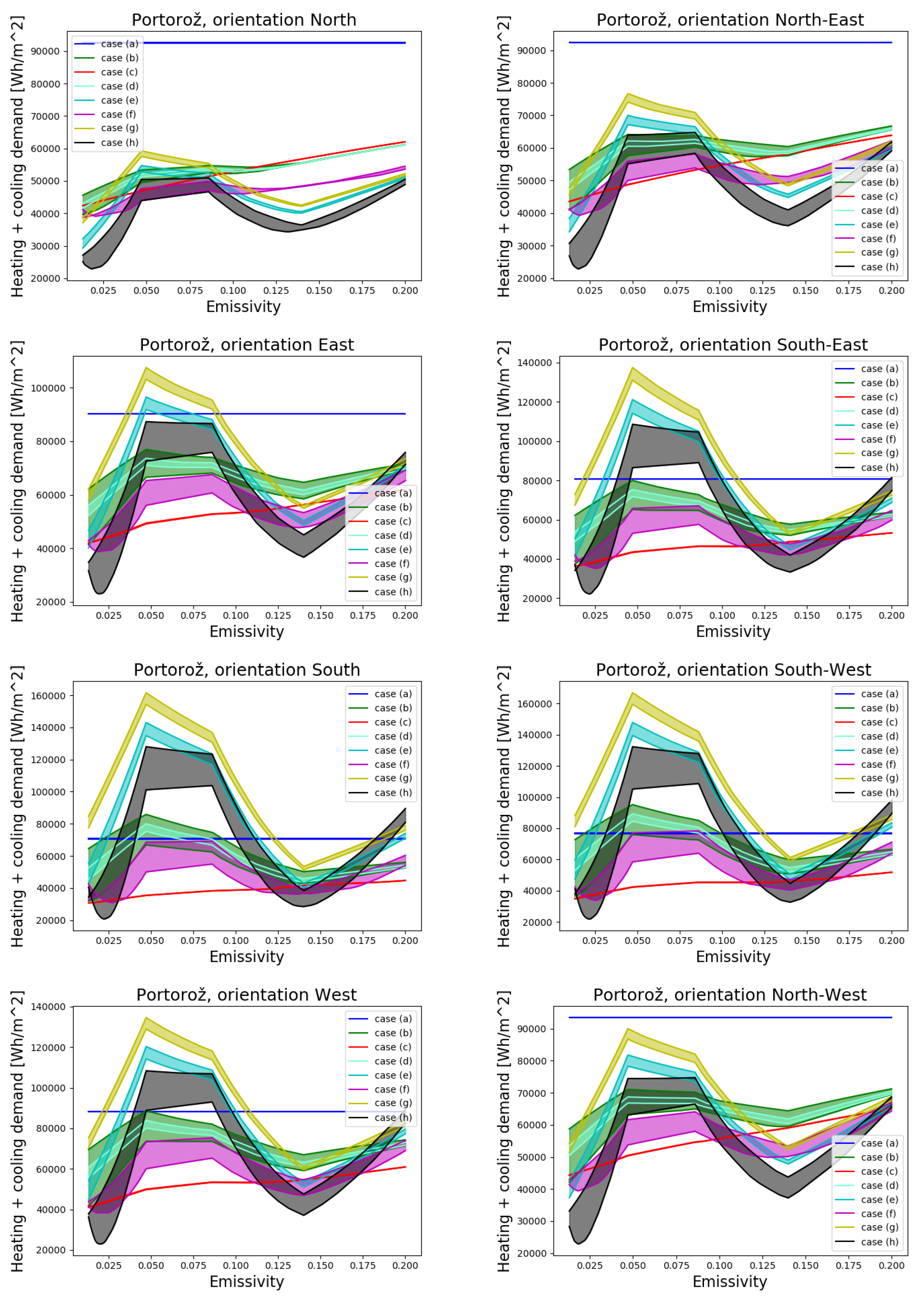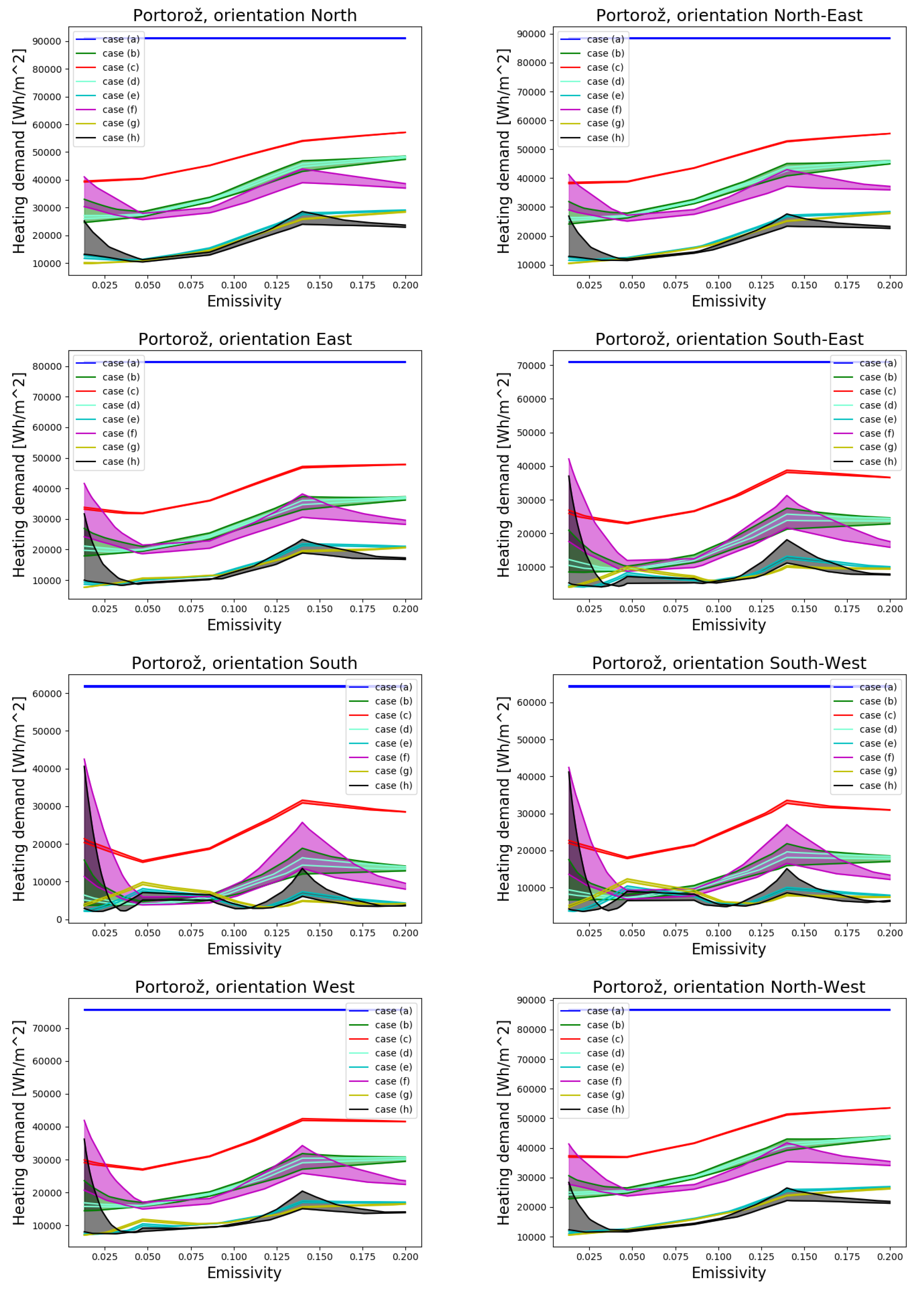Figure 1.
The contribution of incident solar radiation to solar heat gain.
Figure 1.
The contribution of incident solar radiation to solar heat gain.
Figure 2.
Contributions to solar transmittance due to reflections.
Figure 2.
Contributions to solar transmittance due to reflections.
Figure 3.
Distribution of optical properties of glass panes available on European market: (A) thickness, (B) conductivity, (C) emissivity (side A), (D) emissivity (side B), (E) reflectance (side A), (F) reflectance (side B), (G) transmittance. The panes are sorted by studied parameter and than presented in a graph. Each vertical line presents one pane.
Figure 3.
Distribution of optical properties of glass panes available on European market: (A) thickness, (B) conductivity, (C) emissivity (side A), (D) emissivity (side B), (E) reflectance (side A), (F) reflectance (side B), (G) transmittance. The panes are sorted by studied parameter and than presented in a graph. Each vertical line presents one pane.
Figure 4.
Correlation between optical properties of glass panes availabe on European market: (A) transmittance for solar spectrum (horizontal axis) vs visual transmittance (vertical axis), (B) reflectance on a side with low-emissivity coating (horizontal axis) vs emissivity on a side with low-emissivity coating (vertical axis), (C) transmittance (horizontal axis) vs emissivity on a side with low-emissivity coating (vertical axis), (D) emissivity on a side with low-emissivity coating (horizontal axis) vs reflectance on a side without low-emissivity coating (vertical axis), (E) emissivity on a side with low-emissivity coating (horizontal axis) vs transmittance (vertical axis), (F) emissivity on a side with low-emissivity coating (horizontal axis) vs reflectance on a side with low-emissivity coating (vertical axis).
Figure 4.
Correlation between optical properties of glass panes availabe on European market: (A) transmittance for solar spectrum (horizontal axis) vs visual transmittance (vertical axis), (B) reflectance on a side with low-emissivity coating (horizontal axis) vs emissivity on a side with low-emissivity coating (vertical axis), (C) transmittance (horizontal axis) vs emissivity on a side with low-emissivity coating (vertical axis), (D) emissivity on a side with low-emissivity coating (horizontal axis) vs reflectance on a side without low-emissivity coating (vertical axis), (E) emissivity on a side with low-emissivity coating (horizontal axis) vs transmittance (vertical axis), (F) emissivity on a side with low-emissivity coating (horizontal axis) vs reflectance on a side with low-emissivity coating (vertical axis).
Figure 5.
Annual heat loss per square meter of vertically set double glazing system on object located at Kredarica for high impedance building with low solar gains (badly insulated or/and windows with small ratio of window area): (a) both panes with highest transmittance (clear glass without low emissivity coating); (b) internal pane with low emissivity coating, external pane clear glass without low emissivity coating; (c) external pane with low emissivity coating, internal pane clear glass without low emissivity coating; (d) both panes with low emissivity coating. As in case (a) there is no low-emissivity pane, the glazing has fixed emissivity and therefore the results do not vary with the emissivity. Different cases include low-emissivity glass with different values of reflectance.
Figure 5.
Annual heat loss per square meter of vertically set double glazing system on object located at Kredarica for high impedance building with low solar gains (badly insulated or/and windows with small ratio of window area): (a) both panes with highest transmittance (clear glass without low emissivity coating); (b) internal pane with low emissivity coating, external pane clear glass without low emissivity coating; (c) external pane with low emissivity coating, internal pane clear glass without low emissivity coating; (d) both panes with low emissivity coating. As in case (a) there is no low-emissivity pane, the glazing has fixed emissivity and therefore the results do not vary with the emissivity. Different cases include low-emissivity glass with different values of reflectance.
Figure 6.
Annual heat loss per square meter of vertically set double glazing system on object located at Kredarica for high impedance building with high solar gains (well insulated or/and windows with large ratio of window area without shading during cooling season): (a) both panes with highest transmittance (clear glass without low emissivity coating); (b) internal pane with low emissivity coating, external pane clear glass without low emissivity coating; (c) external pane with low emissivity coating, internal pane clear glass without low emissivity coating; (d) both panes with low emissivity coating. As in case (a) there is no low-emissivity pane, the glazing has fixed emissivity and therefore the results do not vary with the emissivity. Different cases include low-emissivity glass with different values of reflectance.
Figure 6.
Annual heat loss per square meter of vertically set double glazing system on object located at Kredarica for high impedance building with high solar gains (well insulated or/and windows with large ratio of window area without shading during cooling season): (a) both panes with highest transmittance (clear glass without low emissivity coating); (b) internal pane with low emissivity coating, external pane clear glass without low emissivity coating; (c) external pane with low emissivity coating, internal pane clear glass without low emissivity coating; (d) both panes with low emissivity coating. As in case (a) there is no low-emissivity pane, the glazing has fixed emissivity and therefore the results do not vary with the emissivity. Different cases include low-emissivity glass with different values of reflectance.
Figure 7.
Annual heat loss per square meter of vertically set triple glazing system on object located at Kredarica for high impedance building with low solar gains (badly insulated or/and windows with small ratio of window area): (a) all panes with clear glass without low emissivity coating; (b) inner pane with low emissivity coating, other panes clear glass; (c) external pane with low emissivity coating, other panes clear glass; (d) middle pane with low emissivity coating, other panes clear glass; (e) inner pane clear glass, other panes with low emissivity coating; (f) external pane clear glass, other panes with low emissivity coating; (g) middle pane with clear glass, other panes with low emissivity coating; (h) all panes with low emissivity coating. As in case (a) there is no low-emissivity pane, the glazing has fixed emissivity and therefore the results do not vary with the emissivity. Different cases include low-emissivity glass with different values of reflectance.
Figure 7.
Annual heat loss per square meter of vertically set triple glazing system on object located at Kredarica for high impedance building with low solar gains (badly insulated or/and windows with small ratio of window area): (a) all panes with clear glass without low emissivity coating; (b) inner pane with low emissivity coating, other panes clear glass; (c) external pane with low emissivity coating, other panes clear glass; (d) middle pane with low emissivity coating, other panes clear glass; (e) inner pane clear glass, other panes with low emissivity coating; (f) external pane clear glass, other panes with low emissivity coating; (g) middle pane with clear glass, other panes with low emissivity coating; (h) all panes with low emissivity coating. As in case (a) there is no low-emissivity pane, the glazing has fixed emissivity and therefore the results do not vary with the emissivity. Different cases include low-emissivity glass with different values of reflectance.
Figure 8.
Annual heat loss per square meter of vertically set triple glazing system on object located at Kredarica for high impedance building with high solar gains (well insulated or/and windows with large ratio of window area without shading during cooling season): (a) all panes with clear glass without low emissivity coating; (b) inner pane with low emissivity coating, other panes clear glass; (c) external pane with low emissivity coating, other panes clear glass; (d) middle pane with low emissivity coating, other panes clear glass; (e) inner pane clear glass, other panes with low emissivity coating; (f) external pane clear glass, other panes with low emissivity coating; (g) middle pane with clear glass, other panes with low emissivity coating; (h) all panes with low emissivity coating. As in case (a) there is no low-emissivity pane, the glazing has fixed emissivity and therefore the results do not vary with the emissivity. Different cases include low-emissivity glass with different values of reflectance.
Figure 8.
Annual heat loss per square meter of vertically set triple glazing system on object located at Kredarica for high impedance building with high solar gains (well insulated or/and windows with large ratio of window area without shading during cooling season): (a) all panes with clear glass without low emissivity coating; (b) inner pane with low emissivity coating, other panes clear glass; (c) external pane with low emissivity coating, other panes clear glass; (d) middle pane with low emissivity coating, other panes clear glass; (e) inner pane clear glass, other panes with low emissivity coating; (f) external pane clear glass, other panes with low emissivity coating; (g) middle pane with clear glass, other panes with low emissivity coating; (h) all panes with low emissivity coating. As in case (a) there is no low-emissivity pane, the glazing has fixed emissivity and therefore the results do not vary with the emissivity. Different cases include low-emissivity glass with different values of reflectance.
![Sustainability 13 11857 g008]()
Figure 9.
Annual heat loss per square meter of vertically set triple glazing system on object located at Kredarica for high impedance building with high solar gains (well insulated or/and windows with large ratio of window area with shading factor 0.2 during cooling season): (a) all panes with clear glass without low emissivity coating; (b) inner pane with low emissivity coating, other panes clear glass; (c) external pane with low emissivity coating, other panes clear glass; (d) middle pane with low emissivity coating, other panes clear glass; (e) inner pane clear glass, other panes with low emissivity coating; (f) external pane clear glass, other panes with low emissivity coating; (g) middle pane with clear glass, other panes with low emissivity coating; (h) all panes with low emissivity coating. As in case (a) there is no low-emissivity pane, the glazing has fixed emissivity and therefore the results do not vary with the emissivity. Different cases include low-emissivity glass with different values of reflectance.
Figure 9.
Annual heat loss per square meter of vertically set triple glazing system on object located at Kredarica for high impedance building with high solar gains (well insulated or/and windows with large ratio of window area with shading factor 0.2 during cooling season): (a) all panes with clear glass without low emissivity coating; (b) inner pane with low emissivity coating, other panes clear glass; (c) external pane with low emissivity coating, other panes clear glass; (d) middle pane with low emissivity coating, other panes clear glass; (e) inner pane clear glass, other panes with low emissivity coating; (f) external pane clear glass, other panes with low emissivity coating; (g) middle pane with clear glass, other panes with low emissivity coating; (h) all panes with low emissivity coating. As in case (a) there is no low-emissivity pane, the glazing has fixed emissivity and therefore the results do not vary with the emissivity. Different cases include low-emissivity glass with different values of reflectance.
![Sustainability 13 11857 g009]()
Figure 10.
Annual heat loss per square meter of vertically set double glazing system on object located at Maribor for high impedance building with low solar gains (badly insulated or/and windows with small ratio of window area): (a) both panes with highest transmittance (clear glass without low emissivity coating); (b) internal pane with low emissivity coating, external pane clear glass without low emissivity coating; (c) external pane with low emissivity coating, internal pane clear glass without low emissivity coating; (d) both panes with low emissivity coating. As in case (a) there is no low-emissivity pane, the glazing has fixed emissivity and therefore the results do not vary with the emissivity. Different cases include low-emissivity glass with different values of reflectance.
Figure 10.
Annual heat loss per square meter of vertically set double glazing system on object located at Maribor for high impedance building with low solar gains (badly insulated or/and windows with small ratio of window area): (a) both panes with highest transmittance (clear glass without low emissivity coating); (b) internal pane with low emissivity coating, external pane clear glass without low emissivity coating; (c) external pane with low emissivity coating, internal pane clear glass without low emissivity coating; (d) both panes with low emissivity coating. As in case (a) there is no low-emissivity pane, the glazing has fixed emissivity and therefore the results do not vary with the emissivity. Different cases include low-emissivity glass with different values of reflectance.
Figure 11.
Annual heat loss per square meter of vertically set double glazing system on object located at Kredarica for high impedance building with high solar gains (well insulated or/and windows with large ratio of window area without shading during cooling season): (a) both panes with highest transmittance (clear glass without low emissivity coating); (b) internal pane with low emissivity coating, external pane clear glass without low emissivity coating; (c) external pane with low emissivity coating, internal pane clear glass without low emissivity coating; (d) both panes with low emissivity coating. As in case (a) there is no low-emissivity pane, the glazing has fixed emissivity and therefore the results do not vary with the emissivity. Different cases include low-emissivity glass with different values of reflectance.
Figure 11.
Annual heat loss per square meter of vertically set double glazing system on object located at Kredarica for high impedance building with high solar gains (well insulated or/and windows with large ratio of window area without shading during cooling season): (a) both panes with highest transmittance (clear glass without low emissivity coating); (b) internal pane with low emissivity coating, external pane clear glass without low emissivity coating; (c) external pane with low emissivity coating, internal pane clear glass without low emissivity coating; (d) both panes with low emissivity coating. As in case (a) there is no low-emissivity pane, the glazing has fixed emissivity and therefore the results do not vary with the emissivity. Different cases include low-emissivity glass with different values of reflectance.
Figure 12.
Annual heat loss per square meter of vertically set double glazing system on object located at Kredarica for high impedance building with high solar gains (well insulated or/and windows with large ratio of window area with shading factor 0.2 during cooling season): (a) both panes with highest transmittance (clear glass without low emissivity coating); (b) internal pane with low emissivity coating, external pane clear glass without low emissivity coating; (c) external pane with low emissivity coating, internal pane clear glass without low emissivity coating; (d) both panes with low emissivity coating. As in case (a) there is no low-emissivity pane, the glazing has fixed emissivity and therefore the results do not vary with the emissivity. Different cases include low-emissivity glass with different values of reflectance.
Figure 12.
Annual heat loss per square meter of vertically set double glazing system on object located at Kredarica for high impedance building with high solar gains (well insulated or/and windows with large ratio of window area with shading factor 0.2 during cooling season): (a) both panes with highest transmittance (clear glass without low emissivity coating); (b) internal pane with low emissivity coating, external pane clear glass without low emissivity coating; (c) external pane with low emissivity coating, internal pane clear glass without low emissivity coating; (d) both panes with low emissivity coating. As in case (a) there is no low-emissivity pane, the glazing has fixed emissivity and therefore the results do not vary with the emissivity. Different cases include low-emissivity glass with different values of reflectance.
Figure 13.
Annual heat loss per square meter of vertically set triple glazing system on object located at Maribor for high impedance building with low solar gains (badly insulated or/and windows with small ratio of window area): (a) all panes with clear glass without low emissivity coating; (b) inner pane with low emissivity coating, other panes clear glass; (c) external pane with low emissivity coating, other panes clear glass; (d) middle pane with low emissivity coating, other panes clear glass; (e) inner pane clear glass, other panes with low emissivity coating; (f) external pane clear glass, other panes with low emissivity coating; (g) middle pane with clear glass, other panes with low emissivity coating; (h) all panes with low emissivity coating. As in case (a) there is no low-emissivity pane, the glazing has fixed emissivity and therefore the results do not vary with the emissivity. Different cases include low-emissivity glass with different values of reflectance.
Figure 13.
Annual heat loss per square meter of vertically set triple glazing system on object located at Maribor for high impedance building with low solar gains (badly insulated or/and windows with small ratio of window area): (a) all panes with clear glass without low emissivity coating; (b) inner pane with low emissivity coating, other panes clear glass; (c) external pane with low emissivity coating, other panes clear glass; (d) middle pane with low emissivity coating, other panes clear glass; (e) inner pane clear glass, other panes with low emissivity coating; (f) external pane clear glass, other panes with low emissivity coating; (g) middle pane with clear glass, other panes with low emissivity coating; (h) all panes with low emissivity coating. As in case (a) there is no low-emissivity pane, the glazing has fixed emissivity and therefore the results do not vary with the emissivity. Different cases include low-emissivity glass with different values of reflectance.
Figure 14.
Annual heat loss per square meter of vertically set triple glazing system on object located at Maribor for high impedance building with high solar gains (well insulated or/and windows with large ratio of window area without shading during cooling season): (a) all panes with clear glass without low emissivity coating; (b) inner pane with low emissivity coating, other panes clear glass; (c) external pane with low emissivity coating, other panes clear glass; (d) middle pane with low emissivity coating, other panes clear glass; (e) inner pane clear glass, other panes with low emissivity coating; (f) external pane clear glass, other panes with low emissivity coating; (g) middle pane with clear glass, other panes with low emissivity coating; (h) all panes with low emissivity coating. As in case (a) there is no low-emissivity pane, the glazing has fixed emissivity and therefore the results do not vary with the emissivity. Different cases include low-emissivity glass with different values of reflectance.
Figure 14.
Annual heat loss per square meter of vertically set triple glazing system on object located at Maribor for high impedance building with high solar gains (well insulated or/and windows with large ratio of window area without shading during cooling season): (a) all panes with clear glass without low emissivity coating; (b) inner pane with low emissivity coating, other panes clear glass; (c) external pane with low emissivity coating, other panes clear glass; (d) middle pane with low emissivity coating, other panes clear glass; (e) inner pane clear glass, other panes with low emissivity coating; (f) external pane clear glass, other panes with low emissivity coating; (g) middle pane with clear glass, other panes with low emissivity coating; (h) all panes with low emissivity coating. As in case (a) there is no low-emissivity pane, the glazing has fixed emissivity and therefore the results do not vary with the emissivity. Different cases include low-emissivity glass with different values of reflectance.
![Sustainability 13 11857 g014]()
Figure 15.
Annual heat loss per square meter of vertically set triple glazing system on object located at Maribor for high impedance building with high solar gains (well insulated or/and windows with large ratio of window area with shading factor 0.2 during cooling season): (a) all panes with clear glass without low emissivity coating; (b) inner pane with low emissivity coating, other panes clear glass; (c) external pane with low emissivity coating, other panes clear glass; (d) middle pane with low emissivity coating, other panes clear glass; (e) inner pane clear glass, other panes with low emissivity coating; (f) external pane clear glass, other panes with low emissivity coating; (g) middle pane with clear glass, other panes with low emissivity coating; (h) all panes with low emissivity coating. As in case (a) there is no low-emissivity pane, the glazing has fixed emissivity and therefore the results do not vary with the emissivity. Different cases include low-emissivity glass with different values of reflectance.
Figure 15.
Annual heat loss per square meter of vertically set triple glazing system on object located at Maribor for high impedance building with high solar gains (well insulated or/and windows with large ratio of window area with shading factor 0.2 during cooling season): (a) all panes with clear glass without low emissivity coating; (b) inner pane with low emissivity coating, other panes clear glass; (c) external pane with low emissivity coating, other panes clear glass; (d) middle pane with low emissivity coating, other panes clear glass; (e) inner pane clear glass, other panes with low emissivity coating; (f) external pane clear glass, other panes with low emissivity coating; (g) middle pane with clear glass, other panes with low emissivity coating; (h) all panes with low emissivity coating. As in case (a) there is no low-emissivity pane, the glazing has fixed emissivity and therefore the results do not vary with the emissivity. Different cases include low-emissivity glass with different values of reflectance.
![Sustainability 13 11857 g015]()
Figure 16.
Annual heat loss per square meter of vertically set double glazing system on object located at Maribor for high impedance building with low solar gains (badly insulated or/and windows with small ratio of window area): (a) both panes with highest transmittance (clear glass without low emissivity coating); (b) internal pane with low emissivity coating, external pane clear glass without low emissivity coating; (c) external pane with low emissivity coating, internal pane clear glass without low emissivity coating; (d) both panes with low emissivity coating. As in case (a) there is no low-emissivity pane, the glazing has fixed emissivity and therefore the results do not vary with the emissivity. Different cases include low-emissivity glass with different values of reflectance.
Figure 16.
Annual heat loss per square meter of vertically set double glazing system on object located at Maribor for high impedance building with low solar gains (badly insulated or/and windows with small ratio of window area): (a) both panes with highest transmittance (clear glass without low emissivity coating); (b) internal pane with low emissivity coating, external pane clear glass without low emissivity coating; (c) external pane with low emissivity coating, internal pane clear glass without low emissivity coating; (d) both panes with low emissivity coating. As in case (a) there is no low-emissivity pane, the glazing has fixed emissivity and therefore the results do not vary with the emissivity. Different cases include low-emissivity glass with different values of reflectance.
Figure 17.
Annual heat loss per square meter of vertically set double glazing system on object located at Portorož for high impedance building with high solar gains (well insulated or/and windows with large ratio of window area without shading during cooling season): (a) both panes with highest transmittance (clear glass without low emissivity coating); (b) internal pane with low emissivity coating, external pane clear glass without low emissivity coating; (c) external pane with low emissivity coating, internal pane clear glass without low emissivity coating; (d) both panes with low emissivity coating. As in case (a) there is no low-emissivity pane, the glazing has fixed emissivity and therefore the results do not vary with the emissivity. Different cases include low-emissivity glass with different values of reflectance.
Figure 17.
Annual heat loss per square meter of vertically set double glazing system on object located at Portorož for high impedance building with high solar gains (well insulated or/and windows with large ratio of window area without shading during cooling season): (a) both panes with highest transmittance (clear glass without low emissivity coating); (b) internal pane with low emissivity coating, external pane clear glass without low emissivity coating; (c) external pane with low emissivity coating, internal pane clear glass without low emissivity coating; (d) both panes with low emissivity coating. As in case (a) there is no low-emissivity pane, the glazing has fixed emissivity and therefore the results do not vary with the emissivity. Different cases include low-emissivity glass with different values of reflectance.
Figure 18.
Annual heat loss per square meter of vertically set double glazing system on object located at Portorož for high impedance building with high solar gains (well insulated or/and windows with large ratio of window area with shading factor 0.2 during cooling season): (a) both panes with highest transmittance (clear glass without low emissivity coating); (b) internal pane with low emissivity coating, external pane clear glass without low emissivity coating; (c) external pane with low emissivity coating, internal pane clear glass without low emissivity coating; (d) both panes with low emissivity coating. As in case (a) there is no low-emissivity pane, the glazing has fixed emissivity and therefore the results do not vary with the emissivity. Different cases include low-emissivity glass with different values of reflectance.
Figure 18.
Annual heat loss per square meter of vertically set double glazing system on object located at Portorož for high impedance building with high solar gains (well insulated or/and windows with large ratio of window area with shading factor 0.2 during cooling season): (a) both panes with highest transmittance (clear glass without low emissivity coating); (b) internal pane with low emissivity coating, external pane clear glass without low emissivity coating; (c) external pane with low emissivity coating, internal pane clear glass without low emissivity coating; (d) both panes with low emissivity coating. As in case (a) there is no low-emissivity pane, the glazing has fixed emissivity and therefore the results do not vary with the emissivity. Different cases include low-emissivity glass with different values of reflectance.
Figure 19.
Annual heat loss per square meter of vertically set triple glazing system on object located at Portorož for high impedance building with low solar gains (badly insulated or/and windows with small ratio of window area): (a) all panes with clear glass without low emissivity coating; (b) inner pane with low emissivity coating, other panes clear glass; (c) external pane with low emissivity coating, other panes clear glass; (d) middle pane with low emissivity coating, other panes clear glass; (e) inner pane clear glass, other panes with low emissivity coating; (f) external pane clear glass, other panes with low emissivity coating; (g) middle pane with clear glass, other panes with low emissivity coating; (h) all panes with low emissivity coating. As in case (a) there is no low-emissivity pane, the glazing has fixed emissivity and therefore the results do not vary with the emissivity. Different cases include low-emissivity glass with different values of reflectance.
Figure 19.
Annual heat loss per square meter of vertically set triple glazing system on object located at Portorož for high impedance building with low solar gains (badly insulated or/and windows with small ratio of window area): (a) all panes with clear glass without low emissivity coating; (b) inner pane with low emissivity coating, other panes clear glass; (c) external pane with low emissivity coating, other panes clear glass; (d) middle pane with low emissivity coating, other panes clear glass; (e) inner pane clear glass, other panes with low emissivity coating; (f) external pane clear glass, other panes with low emissivity coating; (g) middle pane with clear glass, other panes with low emissivity coating; (h) all panes with low emissivity coating. As in case (a) there is no low-emissivity pane, the glazing has fixed emissivity and therefore the results do not vary with the emissivity. Different cases include low-emissivity glass with different values of reflectance.
Figure 20.
Annual heat loss per square meter of vertically set triple glazing system on object located at Portorož for high impedance building with high solar gains (well insulated or/and windows with large ratio of window area without shading during cooling season): (a) all panes with clear glass without low emissivity coating; (b) inner pane with low emissivity coating, other panes clear glass; (c) external pane with low emissivity coating, other panes clear glass; (d) middle pane with low emissivity coating, other panes clear glass; (e) inner pane clear glass, other panes with low emissivity coating; (f) external pane clear glass, other panes with low emissivity coating; (g) middle pane with clear glass, other panes with low emissivity coating; (h) all panes with low emissivity coating. As in case (a) there is no low-emissivity pane, the glazing has fixed emissivity and therefore the results do not vary with the emissivity. Different cases include low-emissivity glass with different values of reflectance.
Figure 20.
Annual heat loss per square meter of vertically set triple glazing system on object located at Portorož for high impedance building with high solar gains (well insulated or/and windows with large ratio of window area without shading during cooling season): (a) all panes with clear glass without low emissivity coating; (b) inner pane with low emissivity coating, other panes clear glass; (c) external pane with low emissivity coating, other panes clear glass; (d) middle pane with low emissivity coating, other panes clear glass; (e) inner pane clear glass, other panes with low emissivity coating; (f) external pane clear glass, other panes with low emissivity coating; (g) middle pane with clear glass, other panes with low emissivity coating; (h) all panes with low emissivity coating. As in case (a) there is no low-emissivity pane, the glazing has fixed emissivity and therefore the results do not vary with the emissivity. Different cases include low-emissivity glass with different values of reflectance.
![Sustainability 13 11857 g020]()
Figure 21.
Annual heat loss per square meter of vertically set triple glazing system on object located at Maribor for high impedance building with high solar gains (well insulated or/and windows with large ratio of window area with shading factor 0.2 during cooling season): (a) all panes with clear glass without low emissivity coating; (b) inner pane with low emissivity coating, other panes clear glass; (c) external pane with low emissivity coating, other panes clear glass; (d) middle pane with low emissivity coating, other panes clear glass; (e) inner pane clear glass, other panes with low emissivity coating; (f) external pane clear glass, other panes with low emissivity coating; (g) middle pane with clear glass, other panes with low emissivity coating; (h) all panes with low emissivity coating. As in case (a) there is no low-emissivity pane, the glazing has fixed emissivity and therefore the results do not vary with the emissivity. Different cases include low-emissivity glass with different values of reflectance.
Figure 21.
Annual heat loss per square meter of vertically set triple glazing system on object located at Maribor for high impedance building with high solar gains (well insulated or/and windows with large ratio of window area with shading factor 0.2 during cooling season): (a) all panes with clear glass without low emissivity coating; (b) inner pane with low emissivity coating, other panes clear glass; (c) external pane with low emissivity coating, other panes clear glass; (d) middle pane with low emissivity coating, other panes clear glass; (e) inner pane clear glass, other panes with low emissivity coating; (f) external pane clear glass, other panes with low emissivity coating; (g) middle pane with clear glass, other panes with low emissivity coating; (h) all panes with low emissivity coating. As in case (a) there is no low-emissivity pane, the glazing has fixed emissivity and therefore the results do not vary with the emissivity. Different cases include low-emissivity glass with different values of reflectance.
![Sustainability 13 11857 g021]()
Table 1.
Climate data for Maribor (Slovenia) [
30].
Table 1.
Climate data for Maribor (Slovenia) [
30].
| Month | 1 | 2 | 3 | 4 | 5 | 6 | 7 | 8 | 9 | 10 | 11 | 12 |
|---|
| T1—average temperature [°C], T2—average highest day temperature [°C] |
| −0.2 | 1.7 | 6.0 | 10.8 | 15.8 | 19.0 | 21.0 | 20.3 | 15.7 | 10.7 | 5.1 | 0.9 |
| 3.9 | 6.6 | 11.4 | 16.2 | 21.3 | 24.4 | 26.6 | 26.1 | 21.4 | 16.0 | 9.2 | 4.4 |
| Energy density of incident solar radiation falling on |
| a vertically set pane during one month period measured in [Wh/m2] |
| N | 474 | 582 | 720 | 1009 | 1175 | 1357 | 1188 | 969 | 834 | 690 | 584 | 494 |
| NE | 504 | 649 | 996 | 1438 | 1789 | 1870 | 1804 | 1564 | 1200 | 823 | 644 | 521 |
| E | 972 | 1257 | 1721 | 2068 | 2414 | 2353 | 2436 | 2286 | 1894 | 1357 | 1101 | 955 |
| SE | 1901 | 2244 | 2366 | 2355 | 2411 | 2223 | 2360 | 2457 | 2387 | 2017 | 1761 | 1749 |
| S | 2521 | 2947 | 2637 | 2263 | 2005 | 1821 | 1860 | 2168 | 2432 | 2283 | 2009 | 2164 |
| SW | 1993 | 2426 | 2256 | 2162 | 2082 | 2069 | 2063 | 2160 | 2065 | 1795 | 1494 | 1634 |
| W | 1032 | 1405 | 1586 | 1839 | 1996 | 2170 | 2129 | 1930 | 1520 | 1138 | 879 | 860 |
| NW | 495 | 676 | 915 | 1307 | 1528 | 1765 | 1668 | 1358 | 993 | 735 | 595 | 501 |
Table 2.
Climate data for the Kredarica (Slovenia) [
30].
Table 2.
Climate data for the Kredarica (Slovenia) [
30].
| Month | 1 | 2 | 3 | 4 | 5 | 6 | 7 | 8 | 9 | 10 | 11 | 12 |
|---|
| —average temperature [°C], —average highest day temperature [°C] |
| −7. 2 | −8.0 | −6.6 | −4.5 | 0.3 | 3.4 | 6.1 | 6.4 | 3.6 | 0.5 | −4.1 | −6.0 |
| −4.4 | −5.0 | −3.8 | −1.9 | 2.7 | 6.0 | 9.1 | 9.3 | 6.4 | 3.1 | −1.3 | −3.2 |
| Energy density of incident solar radiation falling on |
| a vertically set pane during one month period measured in [Wh/m2] |
| N | 299 | 446 | 636 | 968 | 1186 | 1403 | 1314 | 1020 | 806 | 567 | 379 | 288 |
| NE | 308 | 480 | 811 | 1337 | 1741 | 1895 | 1866 | 1507 | 1041 | 640 | 407 | 296 |
| E | 566 | 908 | 1388 | 1915 | 2351 | 2387 | 2523 | 2208 | 1640 | 1017 | 661 | 514 |
| SE | 1140 | 1656 | 1970 | 2213 | 2406 | 2315 | 2564 | 2485 | 2173 | 1563 | 1088 | 974 |
| S | 1595 | 2284 | 2338 | 2194 | 2107 | 2000 | 2252 | 2386 | 2420 | 1928 | 1310 | 1246 |
| SW | 1318 | 1962 | 2115 | 2156 | 2251 | 2291 | 2571 | 2467 | 2214 | 1631 | 1023 | 971 |
| W | 698 | 1167 | 1529 | 1848 | 2151 | 2351 | 2581 | 2199 | 1684 | 1056 | 602 | 510 |
| NW | 317 | 538 | 866 | 1299 | 1613 | 1868 | 1942 | 1513 | 1064 | 628 | 388 | 293 |
Table 3.
Climate data for Portorož (Slovenia) [
30].
Table 3.
Climate data for Portorož (Slovenia) [
30].
| Month | 1 | 2 | 3 | 4 | 5 | 6 | 7 | 8 | 9 | 10 | 11 | 12 |
|---|
| —average temperature [°C], —average highest day temperature [°C] |
| 4.1 | 4.5 | 7.4 | 11.6 | 16.4 | 20.1 | 22.5 | 21.7 | 17.6 | 13.6 | 8.4 | 5.1 |
| 8.6 | 9.7 | 13.1 | 16.8 | 21.8 | 25.5 | 28.4 | 28.2 | 23.9 | 19.0 | 13.2 | 9.7 |
| Energy density of incident solar radiation falling on |
| a vertically set pane during one month period measured in [Wh/m2] |
| N | 335 | 490 | 731 | 1094 | 1341 | 1589 | 1433 | 1193 | 910 | 664 | 430 | 312 |
| NE | 344 | 523 | 884 | 1391 | 1804 | 1980 | 1872 | 1615 | 1133 | 741 | 450 | 318 |
| E | 605 | 945 | 1458 | 1950 | 2427 | 2482 | 2512 | 2342 | 1740 | 1151 | 714 | 530 |
| SE | 1220 | 1730 | 2098 | 2319 | 2554 | 2472 | 2596 | 2682 | 2319 | 1769 | 1185 | 1010 |
| S | 1847 | 2572 | 2683 | 2480 | 2373 | 2257 | 2388 | 2705 | 2728 | 2291 | 1505 | 1394 |
| SW | 1639 | 2422 | 2678 | 2622 | 2700 | 2773 | 2917 | 3045 | 2693 | 2049 | 1239 | 1161 |
| W | 926 | 1550 | 2044 | 2306 | 2661 | 2935 | 3036 | 2853 | 2126 | 1371 | 754 | 640 |
| NW | 378 | 686 | 1133 | 1591 | 1989 | 2320 | 2292 | 1974 | 1306 | 775 | 454 | 323 |
Table 4.
Values of physical constants for argon.
Table 4.
Values of physical constants for argon.
| Temperature [°C] | × kg/m3 | kg/ms | W/mK | J/kgK |
|---|
| −10 | 1.826 | 2.038 | 1.584 | 0.519 |
| 0 | 1.762 | 2.101 | 1.634 | 0.519 |
| 10 | 1.699 | 2.164 | 1.684 | 0.519 |
| 20 | 1.640 | 2.228 | 1.734 | 0.519 |
